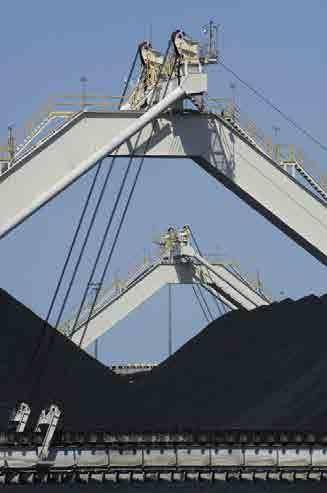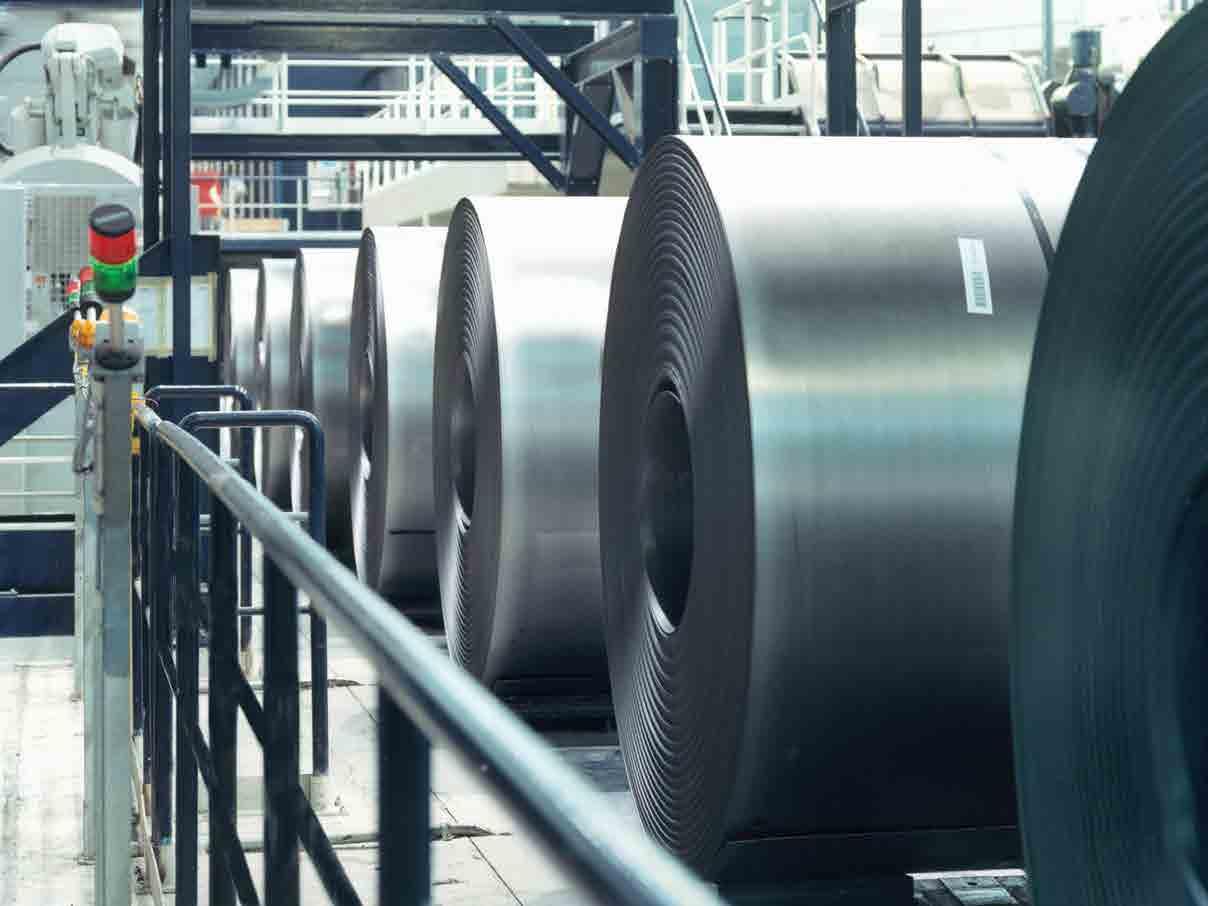
8 minute read
Uncertain outlook Demand rises but risks remain
Cold-rolled steel - ThyssenKrupp
UNCERTAIN OUTLOOK
The global demand for steel rises but risks remain, reports Daniel Gleeson, Metal Bulletin Correspondent.
Lakshmi Mittal, CEO of ArcelorMittal Coking coal has been in short supply after excessive rainfall in Queensland, Australia. Edwin Basson, director general of worldsteel



This is not another 2008. Words to that effect were uttered by the world’s biggest steel maker in September at an investor presentation where CEO of ArcelorMittal Lakshmi Mittal outlined a $1 billion asset optimisation plan that involved shutting down high-cost facilities, mostly in Europe.
These words have not stopped many comparing the financial worries in the eurozone and the US that have affected steel demand to the global crisis in 2008.
“In 2008 and 2009, demand was about 75–80 per cent of normal demand. Today high-strength steels in extremely thin and wide dimensions are operating at 75–80 per cent of normal capacity, so there is no need to cut volume further because we believe customers will need material from us,” Lakshmi Mittal said.
And ArcelorMittal is not the only producer making moves to cut production. ThyssenKrupp, the biggest steel maker in Europe, which at the beginning of 2011 was operating close to 100 per cent, is now operating at 85 per cent of production and will reduce output in Europe by 500,000 tonnes during the last quarter of this year, with most cuts coming from its hot rolled coil production – steel used widely in the automotive industry.
And these might not be the only cuts the steelmaker has to enforce. “ThyssenKrupp Steel Europe is watching developments on the steel markets closely,” a spokesman told Metal Bulletin. “At all events, we are equipped to respond appropriately. If the signals are negative, we will definitely adapt output to market conditions.”
Salzgitter, another big steel producer in Europe, will also be scaling back is strip steel production by 10 per cent or 200,000 tonnes this quarter as a result of weak demand. This is one producer that has been negatively affected by the capital markets.
“There are a lot of rumours in the capital market about a potential recession. We’re asking sales customers, do you hear any bad news? But the bad news is not from the steel-consuming industries,” a spokesman told MB in October. “The reason for the temporary demand weakness is that steel traders and service centres are reducing inventories,” the spokesman said. “I would underline that the fear in the capital markets is not based on fact and we don’t agree with it.”
This shows it is not only the mills that are prepared to cut inventories. Traders and stockholders are also doing likewise. Inventories of steel and steel raw materials throughout the supply chain are low. No-one is willing to speculate on the direction that the industry will take in the near future and therefore are not looking too far forward with their purchases.
Consumption
Still, despite all of the problems experienced in 2011, the most recent projections from the World Steel Association (worldsteel) which has members representing 85 per cent of the world’s steel production, are encouraging.
The association announced its short range outlook at its annual meeting in October in Paris, which stated that apparent steel use globally will increase by 6.5 per cent to 1.398 billion tonnes in 2011, following growth of 15.1 per cent in 2010. Further, in 2012 it forecasted that world steel demand will grow further by 5.4 per cent to 1.474 billion tonnes.
Daniel Novegil, chairman of the worldsteel economics committee, said these projections should be considered as “cautiously optimistic. Looking forward we can expect downside risks,” he said.
The association’s economics committee met in Istanbul in September to finalise the forecast against a background of ‘turmoil and volatility’. “The key words at our Istanbul meeting were: inflation pressure, monetary tightening, foreign exchange moves, uncertainty, volatility, slowdown, recession, premature to estimate,” he said.
In line with this, the first half of the year provided much of the growth.
“In the first half of 2011, we witnessed sustained momentum in the recovery of steel demand globally carrying over from 2010,” Novegil said. “This is despite a series of anticipated and unanticipated negative developments: the ongoing euro area sovereign debt crisis, the earthquakes in Japan, the political/ social unrest in some countries of the MENA [Middle East and North Africa] region leading to the related surge in oil prices and the tightening of government monetary measures in many emerging economies.”
The lingering uncertainty in the current market means that next year’s forecasts are dependent on developing economies leading the way again.
“Our current forecast for 2012 assumes that developing economies continue to drive
global growth and the policy response to the European debt crisis prevents increased volatility in the equity and financial markets,” he added.
This is emphasised with the association’s projections. China’s apparent steel use in 2011 is expected to increase by 7.5 per cent to 643.2 million tonnes following growth of 8.5 per cent in 2010. However, growth is expected to slow for a third consecutive year in 2012, the association said. In 2012, steel demand is expected to lead to 6.0 per cent growth, which will bring China’s apparent steel use to 681.6 million tonnes. With Chinese steel use making up close to 50 per cent of the global figure though, there are a lot of hopes being pinned on the country’s steelmakers and it has economic issues of its own to contend with.
“We know that Europe’s sovereign debt issues and the US slowdown have influenced the world greatly, but China has its own issues as well,” Zhang Xiaogang, the newly appointed chairman of worldsteel said at the annual meeting. “Inflation is a huge problem. We are trying to figure a way out and we don’t have that yet. China’s steel industry goes hand-inhand with overall development, and we have to look at the inflation issue and work it out,” he added.
Aside from China, other developing countries are also contributing to overall expected growth in apparent steel use, worldsteel’s forecasts showed. In 2011, India’s steel use is forecast to grow by 4.3 per cent to reach 67.7 million tonnes due to economic growth within the country, with growth expected to accelerate to 7.9 per cent in 2012.
Central and South America also fit into the expectation of growth in developing countries. Apparent steel use is forecast to grow by 4.7 per cent in 2011 in these continents to reach an historical high of 47.8 million tonnes, with 2012’s figure forecast to reach 52.4 million tonnes, equivalent to 9.8 per cent growth.

High-strength steels in extremely thin and wide dimensions - ThyssenKrupp
Recovery?
These positive projections aside, this year has been very tough for all steel makers. Turkish steel makers were hit by a dearth of demand for long products such as rebar as the Arab Spring impacted consumption in Egypt, Syria and many of the other countries in the Middle East and North Africa (MENA).
This was reflected in demand for steel falling by 0.9 per cent in 2011 in the MENA region, with worldsteel saying the decrease was mainly down to demand in North African countries falling. In 2012 though, the association forecasts growth of 8.7 per cent in apparent steel use in the region. There are still question marks over this figure though. “Given that the political situation in the region is far from settled, there exist considerable uncertainties to the current forecasts for this region,” the association said.
Japanese producers also suffered heavily in 2011. The earthquake and tsunami in March hit their steel industry heavily. Importers of steel products and raw materials were forced to look elsewhere and some of the biggest Japanese steel producers in the world were unable to take delivery of core steel making components with deliveries of iron ore and coking coal being redirected due to damaged ports.
In line with this, Japan’s steel use is expected to decline by 2.7 per cent to 61.8 million tonnes in 2011 due mainly to the disruptions caused by the earthquakes. There are positive notes though, with growth of 0.8 per cent in 2012 meaning apparent steel would hit 62.3 million tonnes for the year.
It is not only Japan that had problems with supplies of raw materials, with iron ore prices lingering near all-time price highs due to mining bans in some of India’s most iron-rich states.
Also, at the beginning of 2011, coking coal, a main component of the traditional steel making process, was in short supply, having been hampered by excessive rainfall in Queensland, Australia. This has affected supply and prices for the steel making raw material for the majority of the year, harming steelmaker’s margins and keeping prices at high levels.
Director general of worldsteel Edwin Basson saw this as a positive though. “There are positives and negatives [to high raw material costs] for our industry, depending on how you look at this,” Basson said. “One of the positives we should all recognise is, with the new conditions in the market, the difference between the marginal cost of producing a tonne of steel and the average cost of producing a tonne of steel is not as large as it used to be, and that in itself must lead to much more disciplined behaviour,” he said. The fact is that steel makers have to adapt to new conditions in the markets they serve and rely on daily. 2011, so far, has been a year of unexpected problems and the industry has tackled them well. Coming into 2012, there are still many financial uncertainties, but steel makers have adapted well to every new challenge that has faced them and they will do likewise next year. n










